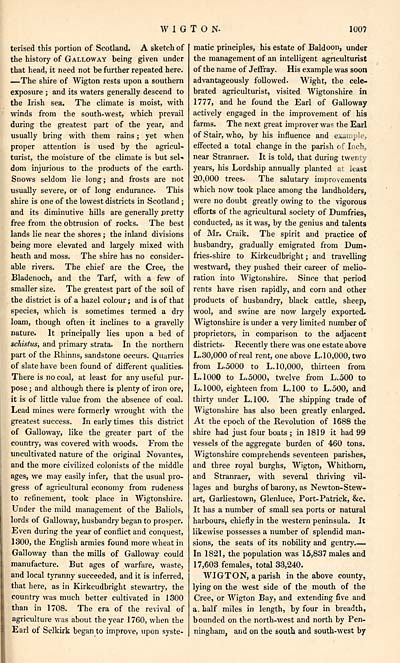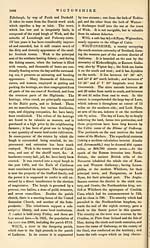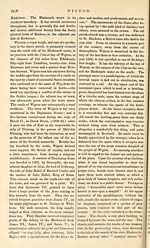Gazetteer of Scotland > Volume 2
(529) Page 1007
Download files
Complete book:
Individual page:
Thumbnail gallery: Grid view | List view

W I G T O N-
100?
terised this portion of Scotland. A sketch of
the history of Galloway being given under
that head, it need not be further repeated here.
— The shire of Wigton rests upon a southern
exposure ; and its waters generally descend to
the Irish sea. The climate is moist, with
winds from the south-west, which prevail
during the greatest part of the year, and
usually bring with them rains ; yet when
proper attention is used by the agricul-
turist, the moisture of the climate is but sel-
dom injurious to the products of the earth.
Snows seldom lie long; and frosts are not
usually severe, or of long endurance. This
shire is one of the lowest districts in Scotland ;
and its diminutive hills are generally pretty
free from the obtrusion of rocks. The best
lands lie near the shores ; the inland divisions
being more elevated and largely mixed with
heath and moss. The shire has no consider-
able rivers. The chief are the Cree, the
Bladenoch, and the Tarf, with a few of
smaller size. The greatest part of the soil of
the district is of a hazel colour ; and is of that
6pecies, which is sometimes termed a dry
loam, though often it inclines to a gravelly
nature. It principally lies upon a bed of
sckistus, and primary strata. In the northern
part of the Rhinns, sandstone occurs. Quarries
of slate have been found of different qualities.
There is no coal, at least for any useful pur-
pose ; and although there is plenty of iron ore,
it is of little value from the absence of coal.
Lead mines were formerly wrought with the
greatest success. In early times this district
of Galloway, like the greater part of the
country, was covered with woods. From the
uncultivated nature of the original Novantes,
and the more civilized colonists of the middle
ages, we may easily infer, that the usual pro-
gress of agricultural economy from rudeness
to refinement, took place in Wigtonsliire.
Under the mild management of the Baliols,
lords of Galloway, husbandry began to prosper.
Even during the year of conflict and conquest,
1300, the English armies found more wheat in
Galloway than the mills of Galloway could
manufacture. But ages of warfare, waste,
and local tyranny succeeded, and it is inferred,
that here, as in Kirkcudbright stewartry, the
country was much better cultivated in 1300
than in 1708. The era of the revival of
agriculture was about the year 1760, when the
Earl of Selkirk began to improve, upon syste-
matic principles, his estate of Baldoon, under
the management of an intelligent agriculturist
of the name of Jeffray. His example was soon
advantageously followed. Wight, the cele-
brated agriculturist, visited Wigtonshire in
1777, and he found the Earl of Galloway
actively engaged in the improvement of his
farms. The next great improver was the Earl
of Stair, who, by his influence and example,
effected a total change in the parish of Inch,
near Stranraer. It is told, that during twenty
years, his Lordship annually planted ai least
20,000 trees. The salutary improvements
which now took place among the landholders,
were no doubt greatly owing to the vigorous
efforts of the agricultural society of Dumfries,
conducted, as it was, by the genius and talents
of Mr. Craik. The spirit and practice of
husbandry, gradually emigrated from Dum-
fries-shire to Kirkcudbright j and travelling
westward, they pushed their career of melio-
ration into Wigtonshire. Since that period
rents have risen rapidly, and corn and other
products of husbandry, black cattle, sheep,
wool, and swine are now largely exported.
Wigtonshire is under a very limited number of
proprietors, in comparison to the adjacent
districts. Recently there was one estate above
L.30,000 of real rent, one above L.10,000, two
from L.5000 to L.10,000, thirteen from
L.1000 to L.5000, twelve from L.500 to
L.1000, eighteen from L.100 to L.500, and
thirty under L.100. The shipping trade of
Wigtonshire has also been greatly enlarged.
At the epoch of the Revolution of 1688 the
shire had just four boats ; in 1819 it had 99
vessels of the aggregate burden of 460 tons.
Wigtonshire comprehends seventeen parishes,
and three royal burghs, Wigton, Whithorn,
and Stranraer, with several thriving vil-
lages and burghs of barony, as Newton-Stew-
art, Garliestown, Glenluce, Port-Patrick, &c.
It has a number of small sea ports or natural
harbours, chiefly in the western peninsula. It
likewise possesses a number of splendid man-
sions, the seats of its nobility and gentry. —
In 1821, the population was 15,837 males and
17,603 females, total 33,240.
WIGTON, a parish in the above county,
lying on the west side of the mouth of the
Cree, or Wigton Bay, and extending five and
a. half miles in length, by four in breadth,
bounded on the north-west and north by Pen-
ningham, and on the south and south-west by
100?
terised this portion of Scotland. A sketch of
the history of Galloway being given under
that head, it need not be further repeated here.
— The shire of Wigton rests upon a southern
exposure ; and its waters generally descend to
the Irish sea. The climate is moist, with
winds from the south-west, which prevail
during the greatest part of the year, and
usually bring with them rains ; yet when
proper attention is used by the agricul-
turist, the moisture of the climate is but sel-
dom injurious to the products of the earth.
Snows seldom lie long; and frosts are not
usually severe, or of long endurance. This
shire is one of the lowest districts in Scotland ;
and its diminutive hills are generally pretty
free from the obtrusion of rocks. The best
lands lie near the shores ; the inland divisions
being more elevated and largely mixed with
heath and moss. The shire has no consider-
able rivers. The chief are the Cree, the
Bladenoch, and the Tarf, with a few of
smaller size. The greatest part of the soil of
the district is of a hazel colour ; and is of that
6pecies, which is sometimes termed a dry
loam, though often it inclines to a gravelly
nature. It principally lies upon a bed of
sckistus, and primary strata. In the northern
part of the Rhinns, sandstone occurs. Quarries
of slate have been found of different qualities.
There is no coal, at least for any useful pur-
pose ; and although there is plenty of iron ore,
it is of little value from the absence of coal.
Lead mines were formerly wrought with the
greatest success. In early times this district
of Galloway, like the greater part of the
country, was covered with woods. From the
uncultivated nature of the original Novantes,
and the more civilized colonists of the middle
ages, we may easily infer, that the usual pro-
gress of agricultural economy from rudeness
to refinement, took place in Wigtonsliire.
Under the mild management of the Baliols,
lords of Galloway, husbandry began to prosper.
Even during the year of conflict and conquest,
1300, the English armies found more wheat in
Galloway than the mills of Galloway could
manufacture. But ages of warfare, waste,
and local tyranny succeeded, and it is inferred,
that here, as in Kirkcudbright stewartry, the
country was much better cultivated in 1300
than in 1708. The era of the revival of
agriculture was about the year 1760, when the
Earl of Selkirk began to improve, upon syste-
matic principles, his estate of Baldoon, under
the management of an intelligent agriculturist
of the name of Jeffray. His example was soon
advantageously followed. Wight, the cele-
brated agriculturist, visited Wigtonshire in
1777, and he found the Earl of Galloway
actively engaged in the improvement of his
farms. The next great improver was the Earl
of Stair, who, by his influence and example,
effected a total change in the parish of Inch,
near Stranraer. It is told, that during twenty
years, his Lordship annually planted ai least
20,000 trees. The salutary improvements
which now took place among the landholders,
were no doubt greatly owing to the vigorous
efforts of the agricultural society of Dumfries,
conducted, as it was, by the genius and talents
of Mr. Craik. The spirit and practice of
husbandry, gradually emigrated from Dum-
fries-shire to Kirkcudbright j and travelling
westward, they pushed their career of melio-
ration into Wigtonshire. Since that period
rents have risen rapidly, and corn and other
products of husbandry, black cattle, sheep,
wool, and swine are now largely exported.
Wigtonshire is under a very limited number of
proprietors, in comparison to the adjacent
districts. Recently there was one estate above
L.30,000 of real rent, one above L.10,000, two
from L.5000 to L.10,000, thirteen from
L.1000 to L.5000, twelve from L.500 to
L.1000, eighteen from L.100 to L.500, and
thirty under L.100. The shipping trade of
Wigtonshire has also been greatly enlarged.
At the epoch of the Revolution of 1688 the
shire had just four boats ; in 1819 it had 99
vessels of the aggregate burden of 460 tons.
Wigtonshire comprehends seventeen parishes,
and three royal burghs, Wigton, Whithorn,
and Stranraer, with several thriving vil-
lages and burghs of barony, as Newton-Stew-
art, Garliestown, Glenluce, Port-Patrick, &c.
It has a number of small sea ports or natural
harbours, chiefly in the western peninsula. It
likewise possesses a number of splendid man-
sions, the seats of its nobility and gentry. —
In 1821, the population was 15,837 males and
17,603 females, total 33,240.
WIGTON, a parish in the above county,
lying on the west side of the mouth of the
Cree, or Wigton Bay, and extending five and
a. half miles in length, by four in breadth,
bounded on the north-west and north by Pen-
ningham, and on the south and south-west by
Set display mode to: Large image | Transcription
Images and transcriptions on this page, including medium image downloads, may be used under the Creative Commons Attribution 4.0 International Licence unless otherwise stated. ![]()
| Gazetteers of Scotland, 1803-1901 > Gazetteer of Scotland > Volume 2 > (529) Page 1007 |
|---|
| Permanent URL | https://digital.nls.uk/97437170 |
|---|
| Description | Volume II: Glenbanchor to Zetland. |
|---|---|
| Attribution and copyright: |
|
| Description | By Robert Chambers and William Chambers. Glasgow: Blackie & Son, 1838. 2 volumes. |
|---|---|
| Shelfmark | NF.1461.g.7 |
| Additional NLS resources: | |

